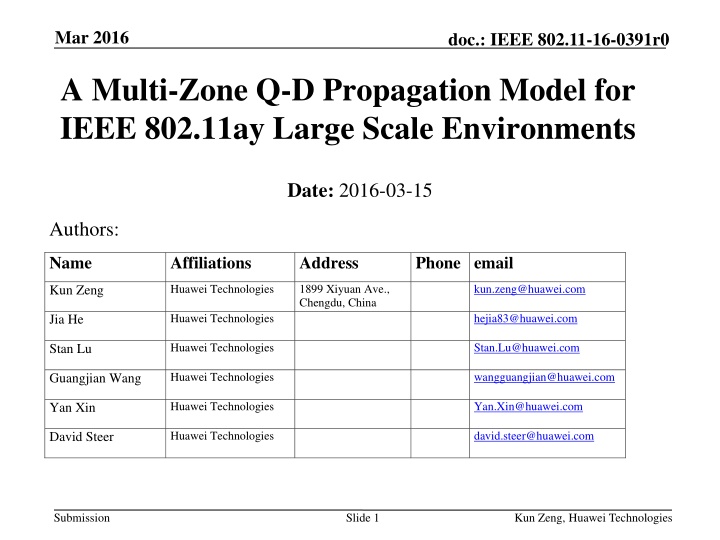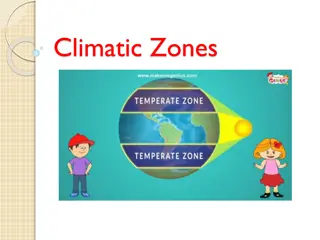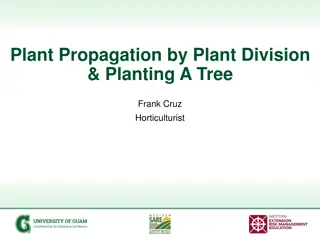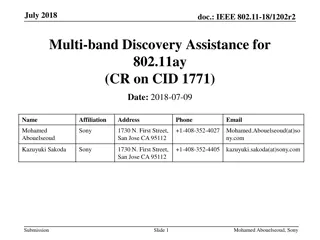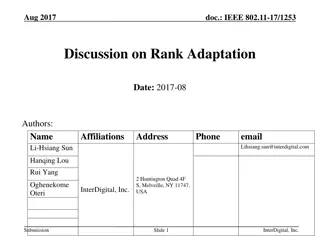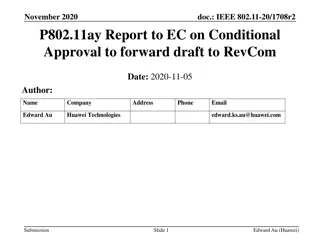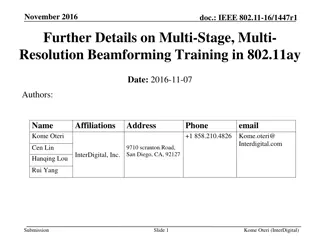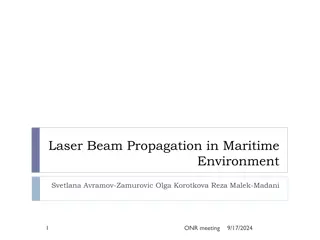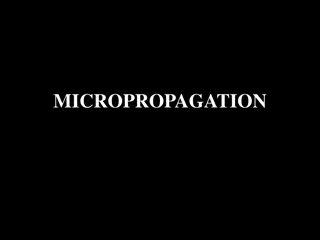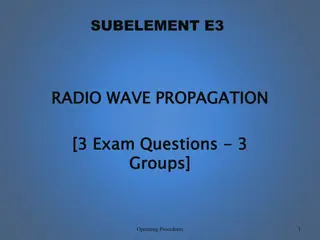Multi-Zone Propagation Model for IEEE 802.11ay Large Scale Environments
The presentation by Huawei Technologies introduces a multi-zone propagation model for IEEE 802.11ay in large-scale scenarios operating in the 60 GHz band. It aims to address the diverse physical effects experienced by signals over long distances, complementing the existing Q-D channel model for more accurate representation. The model reflects various transmission zones and preliminary results, offering insights into signal strengths and propagation characteristics.
Download Presentation

Please find below an Image/Link to download the presentation.
The content on the website is provided AS IS for your information and personal use only. It may not be sold, licensed, or shared on other websites without obtaining consent from the author.If you encounter any issues during the download, it is possible that the publisher has removed the file from their server.
You are allowed to download the files provided on this website for personal or commercial use, subject to the condition that they are used lawfully. All files are the property of their respective owners.
The content on the website is provided AS IS for your information and personal use only. It may not be sold, licensed, or shared on other websites without obtaining consent from the author.
E N D
Presentation Transcript
Mar 2016 doc.: IEEE 802.11-16-0391r0 A Multi-Zone Q-D Propagation Model for IEEE 802.11ay Large Scale Environments Date: 2016-03-15 Authors: Name Affiliations Address Phone email Huawei Technologies 1899 Xiyuan Ave., Chengdu, China kun.zeng@huawei.com Kun Zeng Huawei Technologies hejia83@huawei.com Jia He Huawei Technologies Stan.Lu@huawei.com Stan Lu Huawei Technologies wangguangjian@huawei.com Guangjian Wang Huawei Technologies Yan.Xin@huawei.com Yan Xin Huawei Technologies david.steer@huawei.com David Steer Submission Slide 1 Kun Zeng, Huawei Technologies
Mar 2016 doc.: IEEE 802.11-16-0391r0 Motivation 802.11ay introduces new large scale scenarios [1], such as open area, street canyon, etc.. Due to the fact that 802.11ay operates in the 60 GHz band, if the propagation distance is up to several hundred meters, signal propagation may experience multiple significantly different physical effects during its journey. In order to accurately reflect these effects, this presentation shows a multi-zone propagation model* for 802.11ay new large-scale scenarios. * The model could be complementary with the Q-D channel model in 11ay. Submission Slide 2 Kun Zeng, Huawei Technologies
Mar 2016 An Illustration of Physical Propagation Effects doc.: IEEE 802.11-16-0391r0 Zone 1 (close range free space) direct path with few reflections Zone 2 (LOS/scattered/waveguide) direct path with significant close reflections Zone 3 (NLOS scattered) strong reflections with some weak direct path energy Zone 4 (distant NLOS) both direct and reflected signals are weak ** The thicknesses of lines stand for the strengths of signal. Submission Slide 3 Kun Zeng, Huawei Technologies
Mar 2016 Preliminary Results of Propagation Effects in Different Transmission Zones doc.: IEEE 802.11-16-0391r0 TX 73GHz measurement campaign; Open office scenario; RX position A is 6.03m away RX from TX; position A RX position B is 12.79m away from TX; RX position B Submission Slide 4 Kun Zeng, Huawei Technologies
Mar 2016 Preliminary Results of Propagation Effects in Different Transmission Zones (2) doc.: IEEE 802.11-16-0391r0 TX Joint domain spectrum @ position A A A B Main lobe LOS Glass reflections RX position A B RX position B Position A (near-end): narrow delay spread & angular spread; Submission Slide 5 Kun Zeng, Huawei Technologies
Mar 2016 Preliminary Results of Propagation Effects in Different Transmission Zones (3) doc.: IEEE 802.11-16-0391r0 TX 2 order reflections Joint domain spectrum @ position B RX position A Glass reflections B A RX position B Position B (far-end): wide delay spread & narrow angular spread; Submission Slide 6 Kun Zeng, Huawei Technologies
Mar 2016 doc.: IEEE 802.11-16-0391r0 It looks like that we need more than one set of parameters to reflect the characteristics of channel Submission Slide 7 Kun Zeng, Huawei Technologies
Mar 2016 CIR Structure of Different Zones based on Q-D Channel Modeling Approach doc.: IEEE 802.11-16-0391r0 Copy from [1] RX locates in the zone that the propagation is dominated by the direct path and significant close reflections Submission Slide 8 Kun Zeng, Huawei Technologies
Mar 2016 CIR Structure of Different Zones based on Q-D Channel Modeling Approach (2) doc.: IEEE 802.11-16-0391r0 Power, angular spread (AS), or delay spread (DS) may change RX TX RX locates in the zone that the propagation is mainly by the reflections with some direct path energy but these are attenuated by distance. Submission Slide 9 Kun Zeng, Huawei Technologies
Mar 2016 doc.: IEEE 802.11-16-0391r0 Zones for 11ay New Large-Scale Environments The typical deployment scenario may overlap multiple propagation zones depending on the details of the environments. Therefore, for example for 11ay new large-scale scenarios, Open area Zones 1 and 2; Street canyon Zone 2 and 3; Hotel lobby Zone 1, 2 and 3; Submission Slide 10 Kun Zeng, Huawei Technologies
Mar 2016 doc.: IEEE 802.11-16-0391r0 Zone Determination Criteria Option 1 -- Distance Criterion According to prior information, a distance within d1 could be classified into Zone 1, and a distance with d2 to d3 could be considered as Zone 2, etc.. Option 2 Power Criterion based on D-rays ray tracing According to the strength of D-rays, e.g., if the LOS ray is significantly larger than the 1st order reflection ray, then Zone 1 is determined; After that, R-rays are modeled in each zone. Option 3 Clustering Criterion based on R-rays statistical measurements Clustering of the joint domain spectrum, and then zones are determined based on the characteristics of the clusters, e.g., narrow delay spread and angular spread corresponds to Zone 2. After that, D-rays are calculated in each zone. Submission Slide 11 Kun Zeng, Huawei Technologies
Mar 2016 doc.: IEEE 802.11-16-0391r0 References [1] IEEE 802.11-15/1150r2, Channel Models for IEEE 802.11ay Submission Slide 12 Kun Zeng, Huawei Technologies
